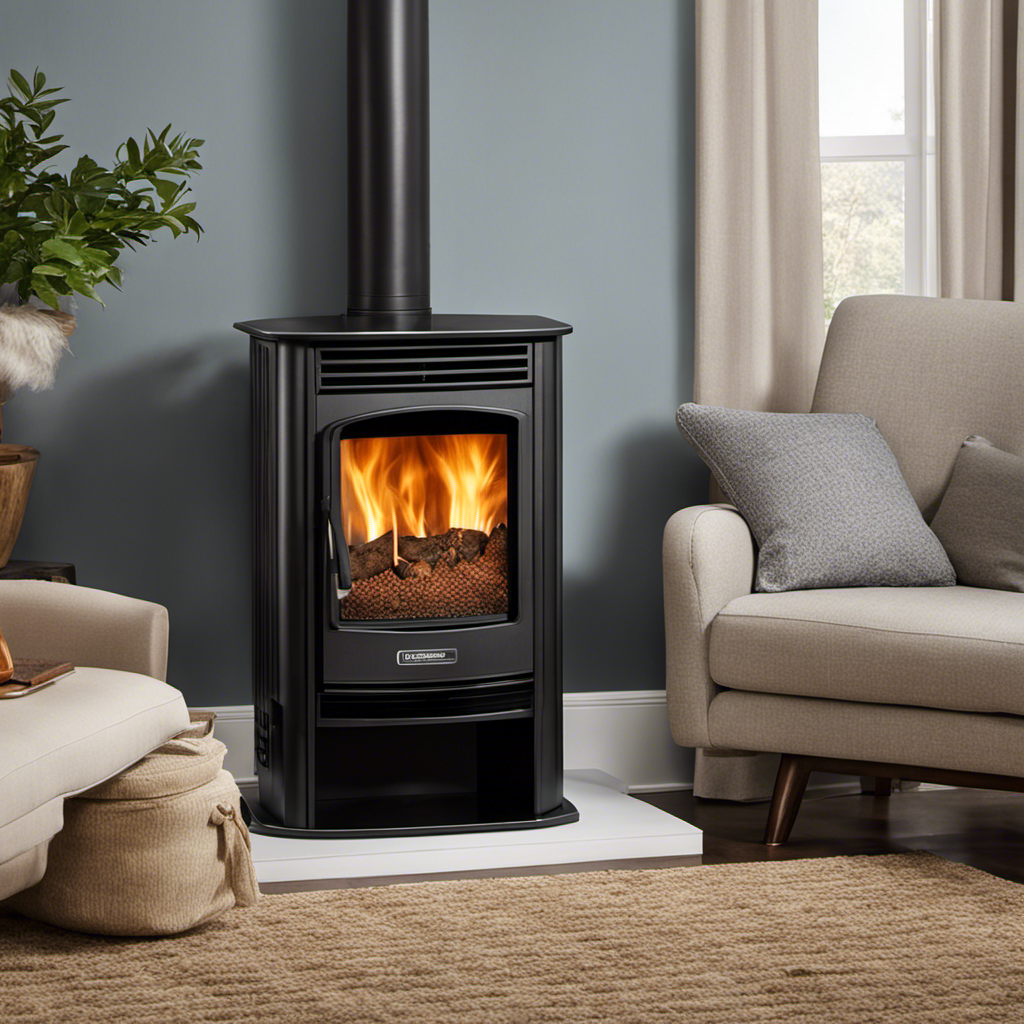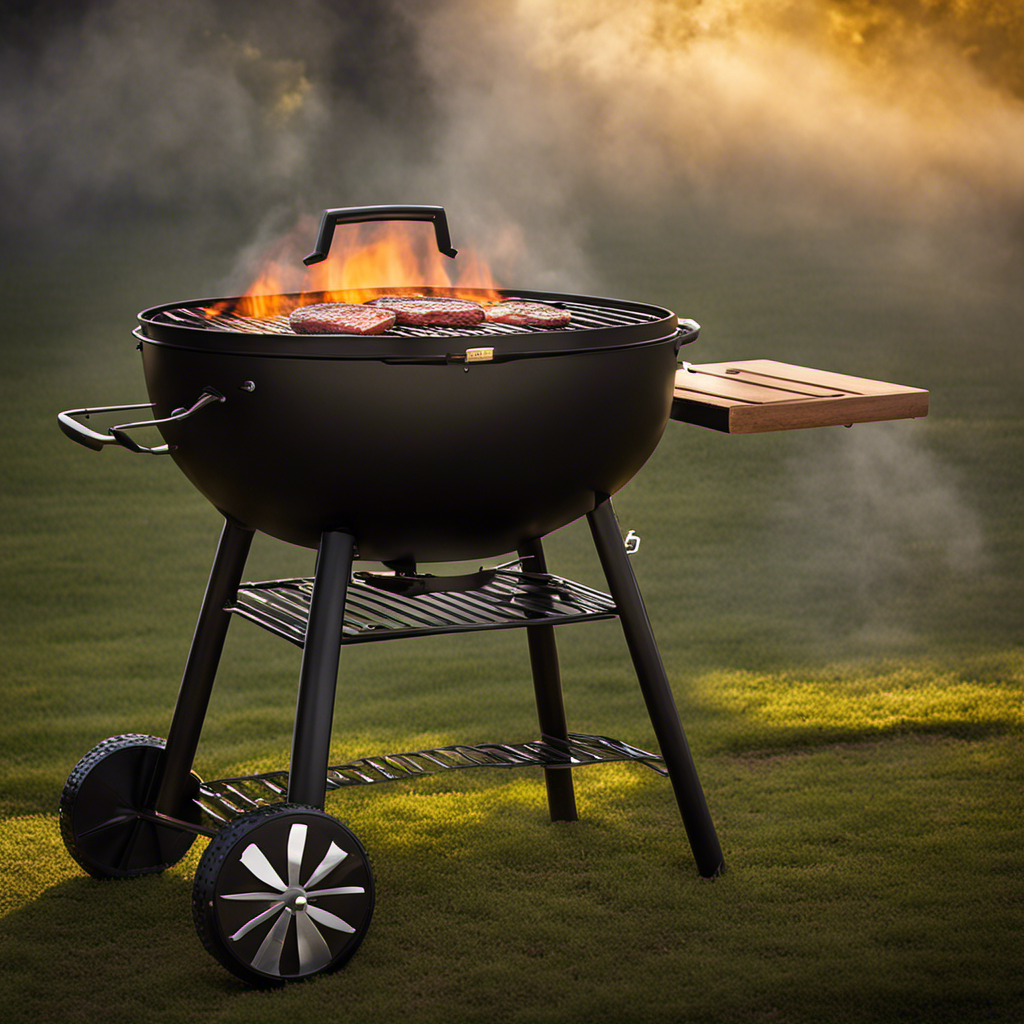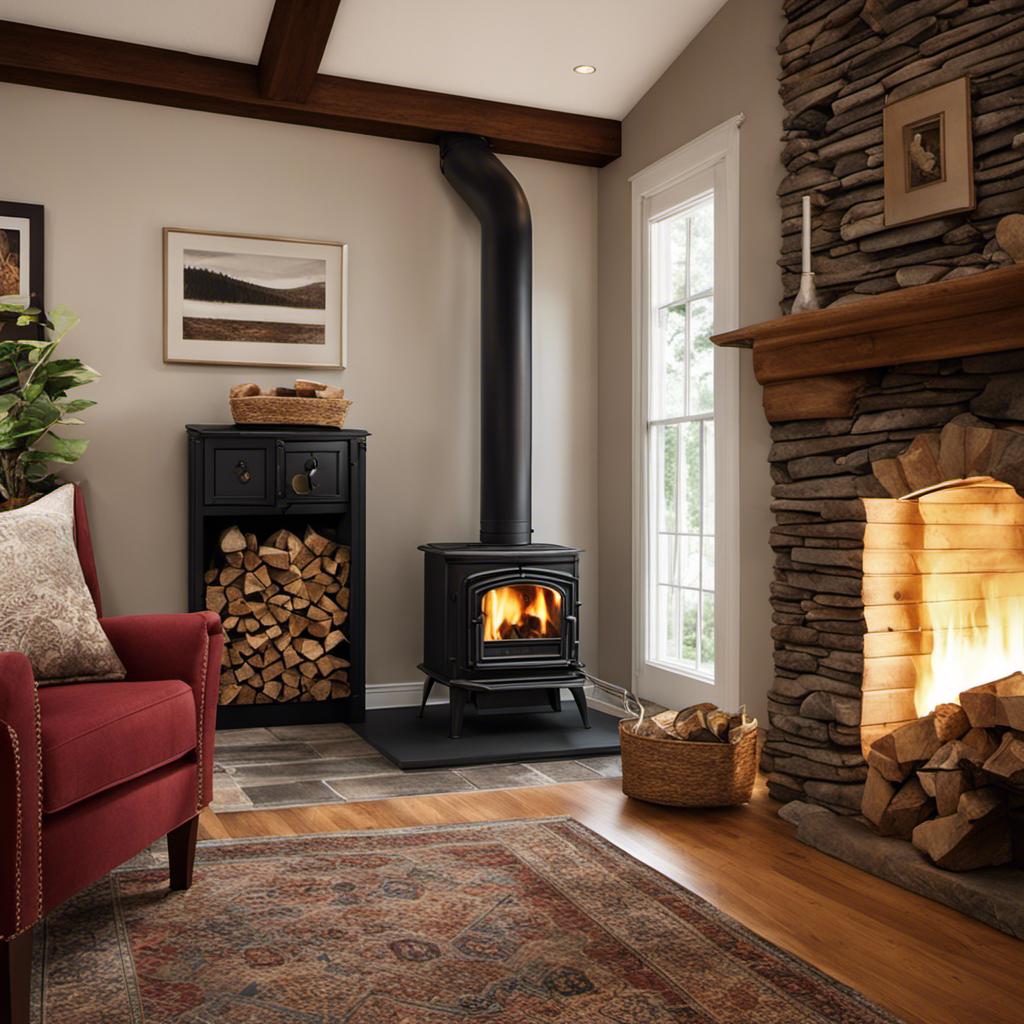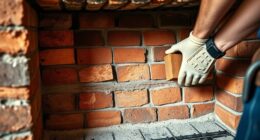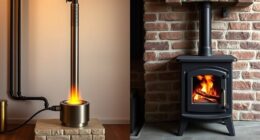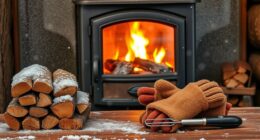When I step into my cozy living room during a chilly winter evening, the warmth from my wood pellet stove instantly envelopes me. However, there’s just one thing that bothers me – the constant aroma of wood smoke.
But fear not, fellow wood pellet stove owners, for I have embarked on a quest to find the ultimate solution. In this article, I will delve into the causes of this pesky odor and provide you with evidence-based techniques to eliminate it once and for all.
So, let’s dive in and reclaim the sweet scent of a clean-burning wood pellet stove.
Key Takeaways
- Using high-quality pellets and ensuring efficient combustion can reduce the smoke smell.
- Proper ventilation and airflow control are crucial for eliminating wood smoke odor.
- Regular cleaning and maintenance of the stove and chimney are necessary to prevent odor buildup.
- Additional tips include using natural remedies, improving ventilation, and burning odor-reducing pellets.
Understanding the Causes of Wood Smoke Smell in a Wood Pellet Stove
To understand why your wood pellet stove smells like wood smoke, you need to know the potential causes.
There are several factors that can contribute to the smoke smell in your wood pellet stove. One possible cause is the quality of the pellets you are using. Low-quality pellets can produce more smoke and odor.
Another factor could be the combustion process itself. Inefficient burning can result in incomplete combustion, leading to the release of smoke and odor.
Additionally, a dirty or clogged stove can hinder proper airflow and ventilation, causing the smoke smell to linger.
Minimizing the smoke smell in your wood pellet stove involves addressing these potential causes. By using high-quality pellets, ensuring efficient combustion, and maintaining proper ventilation and airflow in your wood pellet stove, you can effectively reduce the wood smoke smell.
Proper Ventilation and Airflow in Your Wood Pellet Stove
Proper ventilation and airflow are crucial for the efficient and safe operation of a wood pellet stove. Without adequate ventilation, harmful gases and pollutants can accumulate, posing health risks to occupants.
To ensure optimal airflow, it is important to regularly clean the stove’s exhaust system, inspect the air intake, and adjust the damper settings accordingly.
Additionally, eliminating wood smoke odor can be achieved by using high-quality wood pellets and regularly cleaning the stove’s components, such as the burn pot and ash pan.
Importance of Ventilation
Make sure you have proper ventilation to prevent the wood smoke smell from lingering in your home.
Proper ventilation is crucial for maintaining good indoor air quality and preventing potential health risks associated with wood smoke.
It is important to understand that wood smoke contains harmful pollutants such as carbon monoxide, particulate matter, and volatile organic compounds. These pollutants can have detrimental effects on our respiratory system, especially for individuals with pre-existing respiratory conditions or compromised immune systems.
By ensuring proper ventilation, we can effectively remove these pollutants from our living spaces and maintain a healthy indoor environment.
In the next section, we will explore some airflow control tips to further enhance the effectiveness of your wood pellet stove in minimizing the wood smoke smell.
Airflow Control Tips
Ensure that your home has proper airflow control to reduce the lingering smell of wood smoke. Improving insulation and troubleshooting common airflow problems are essential steps to achieve this.
One way to improve insulation is by sealing any gaps or cracks in windows, doors, and walls. This helps to prevent the entry of cold air from outside and the escape of warm air from inside.
Additionally, checking and cleaning the air vents and ducts regularly ensures that air can flow freely throughout the house. Troubleshooting common airflow problems, such as blocked vents or a malfunctioning HVAC system, can also help to eliminate the smell of wood smoke.
By addressing these issues, you can create a healthier and more comfortable living environment.
Now, let’s explore effective methods for eliminating wood smoke odor.
Eliminating Wood Smoke Odor
To get rid of the lingering smell of wood smoke, it’s important to try effective methods for eliminating the odor. One key aspect to consider is ventilation maintenance. Ensuring proper airflow in your home is crucial to prevent the buildup of smoke smell. Regularly clean and inspect your vents and air filters to remove any residue or blockages that may be causing the odor to linger.
Additionally, consider using alternative fuel sources for your wood pellet stove. Some wood pellets are made from hardwood, which can produce less smoke and odor compared to softwood pellets. By choosing the right wood pellets, you can minimize the smoke smell and enjoy a cleaner, fresher environment.
Now, let’s delve into the next section on choosing the right wood pellets to minimize smoke smell.
Choosing the Right Wood Pellets to Minimize Smoke Smell
Selecting the proper wood pellets can significantly reduce the strong smell of wood smoke in your wood pellet stove. When it comes to minimizing smoke smell, choosing alternative fuels such as high-quality wood pellets is crucial. Look for pellets that are made from hardwood, as they tend to produce less smoke and have a higher heat output.
Additionally, opt for pellets that have a low moisture content, as this can further reduce smoke emissions. Proper maintenance of the stove is also essential in preventing excessive smoke smell. Regularly clean the stove, remove any ash buildup, and ensure that the air vents are not blocked.
Cleaning and Maintaining the Chimney and Flue of Your Wood Pellet Stove
Cleaning and maintaining the chimney and flue of your wood pellet stove is essential for preventing a lingering wood smoke smell in your home. Neglecting chimney maintenance can lead to the buildup of creosote, a highly flammable substance that can cause chimney fires. Regular flue cleaning helps to remove creosote and other debris, ensuring proper ventilation and preventing the smoky odor.
Here are some important steps to consider:
- Schedule an annual chimney inspection by a professional to identify any issues or blockages.
- Clean the flue regularly using a chimney brush to remove creosote buildup.
- Use a high-quality chimney cleaner or creosote remover to break down and remove stubborn deposits.
- Check for any cracks or leaks in the chimney or flue liner and repair them promptly.
- Install a chimney cap to prevent debris and animals from entering the chimney.
By following these maintenance practices, you can reduce the risk of chimney fires and minimize the wood smoke smell in your home.
Transition: Now let’s move on to addressing issues with combustion and fuel efficiency in your wood pellet stove.
Addressing Issues With Combustion and Fuel Efficiency in Your Wood Pellet Stove
When it comes to addressing issues with combustion and fuel efficiency in my wood pellet stove, I have found that improving air circulation plays a crucial role.
By ensuring proper air circulation, I can optimize the combustion process and reduce the risk of incomplete burning, which can lead to increased emissions and decreased efficiency.
Additionally, regularly cleaning stove components such as the burn pot, heat exchanger, and exhaust vent can help remove any buildup or blockages that may hinder proper combustion and reduce fuel efficiency.
Lastly, using high-quality pellets is essential for achieving optimal combustion and fuel efficiency in my wood pellet stove.
These pellets are typically made from compressed sawdust or agricultural residues, ensuring a consistent fuel source that burns efficiently and produces minimal ash and emissions.
Improving Air Circulation
Increasing the airflow in your home can help reduce the wood smoke smell from your wood pellet stove. Here are four ways to improve airflow and reduce odors:
-
Open windows and doors: By allowing fresh air to enter your home, you can create a better flow and reduce the concentration of smoke odors.
-
Use fans: Positioning fans strategically can circulate the air and help eliminate lingering odors. Place them near windows or doors to create a cross breeze.
-
Clean air vents and filters: Regularly clean and maintain your home’s air vents and filters to ensure proper airflow. Clogged vents can impede the circulation of fresh air and allow odors to build up.
-
Install an air purifier: Consider installing an air purifier with a HEPA filter. These devices can help remove particles and odors from the air, improving indoor air quality.
By improving airflow, you can effectively reduce the wood smoke smell in your home.
Transitioning into the subsequent section, let’s now explore the importance of cleaning stove components.
Cleaning Stove Components
To effectively reduce the wood smoke smell in your home, it’s important to regularly maintain and clean the components of your stove. Cleaning techniques play a crucial role in removing stubborn odors and ensuring proper functioning of your wood pellet stove.
Start by cleaning the ash pan and removing any built-up debris or ash. Use a vacuum cleaner or a brush to clean the burn pot and the exhaust pipe. Pay special attention to the crevices and corners where residue can accumulate.
Wipe down the glass door with a damp cloth to remove any soot or grime. Regularly clean the stove’s air intake and exhaust vents to prevent blockages. Lastly, clean the stove’s fan and blower to ensure optimal airflow.
Using High-Quality Pellets
Using high-quality pellets ensures that your stove operates efficiently and reduces any lingering odors in your home. Improving pellet quality is essential for troubleshooting pellet stove issues, such as excessive smoke or unpleasant smells. Low-quality pellets can contain impurities or excessive moisture, which can lead to incomplete combustion and the release of more smoke and odor.
Look for pellets made from hardwood, as they tend to burn cleaner and produce less smoke. It is also important to check the moisture content of the pellets, as higher moisture levels can result in more smoke. Additionally, choosing pellets with a consistent size and shape can help prevent clogs and ensure a steady and efficient burn.
Using Proper Fire Starters and Ignition Techniques to Reduce Smoke Smell
Try using the right fire starters and ignition techniques to minimize the smell of wood smoke in your wood pellet stove. When it comes to fire starters, there are several alternatives you can consider. Instead of using newspaper, which can produce a strong smell when burned, try using fire starter cubes or gel. These options are odorless and can effectively ignite your pellets without adding any unwanted scent to your stove. In addition to the type of fire starter, the way you ignite your pellets can also impact the smell. Make sure to follow the manufacturer’s instructions for proper ignition techniques. This will ensure that the pellets ignite evenly and efficiently, reducing the amount of smoke produced. By using the right fire starters and ignition techniques, you can troubleshoot and minimize the smoke smell in your wood pellet stove.
| Fire Starter Alternatives | Benefits |
|---|---|
| Fire starter cubes | Odorless |
| Fire starter gel | Odorless |
To further improve the burning process, adjusting the air intake and burn rate can help achieve a cleaner burn in your wood pellet stove.
Adjusting the Air Intake and Burn Rate for a Cleaner Burning Wood Pellet Stove
Adjusting the air intake and burn rate can result in a cleaner burn, reducing the smell of wood smoke in your stove. When the air intake is too high, it can cause incomplete combustion, leading to more smoke and a stronger odor. To reduce smoke odor, start by adjusting the air intake to a level that promotes efficient burning. This can be done by gradually decreasing the air intake until you achieve a blue, steady flame.
Additionally, adjusting the burn rate can also help reduce smoke smell. Increasing the burn rate can lead to a hotter fire, which can burn off more of the volatile compounds responsible for the smoke odor. By finding the right balance between air intake and burn rate, you can significantly minimize the smell of wood smoke in your wood pellet stove.
Now let’s explore some additional tips and tricks for eliminating wood smoke odor from your stove.
Additional Tips and Tricks for Eliminating Wood Smoke Odor From Your Wood Pellet Stove
To reduce the smell of wood smoke in your stove, consider cleaning the chimney regularly to remove any built-up creosote. This is an important step in maintaining the efficiency and safety of your wood pellet stove.
In addition to regular chimney cleaning, there are several other tips and tricks you can try to eliminate the wood smoke smell from your stove:
- Use natural remedies such as vinegar or baking soda to absorb odors.
- Place bowls of activated charcoal near the stove to help neutralize the smell.
- Open windows and doors to improve ventilation and allow fresh air to circulate.
- Burn specially formulated odor-reducing pellets in your stove.
- Clean the stove’s interior and components regularly to remove any lingering smoke residue.
Are there any specific tips to prevent wood pellet stoves from emitting a strong wood smoke smell?
Yes, there are specific tips to prevent the truth about pellet stove smells from emitting a strong wood smoke smell. Regularly cleaning the stove and chimney, using high-quality pellets, and adjusting the air intake can all help minimize the wood smoke smell from wood pellet stoves.
What Are Effective Ways to Eliminate Wood Smoke Smell from a Pellet Stove?
If you’re seeking the truth about pellet stove smells, there are effective ways to eliminate wood smoke smell from a pellet stove. Regular cleaning of the stove and chimney, using odor-neutralizing pellets, and proper ventilation can all help reduce and eliminate the lingering wood smoke smell from your pellet stove.
Frequently Asked Questions
How Often Should I Clean the Chimney and Flue of My Wood Pellet Stove?
I clean the chimney and flue of my wood pellet stove once a year to ensure proper ventilation and prevent any build-up that could lead to a smoky smell or poor performance.
Can I Use Any Type of Wood Pellets for My Wood Pellet Stove?
I’ve researched the topic extensively, and it’s important to note that using the right type of wood pellets is crucial for optimal performance. Different types of wood pellets can affect the smell of wood smoke in a wood pellet stove. Therefore, it’s essential to follow best practices and use high-quality wood pellets recommended by the manufacturer.
What Can I Do if My Wood Pellet Stove Is Still Producing Smoke Even After Cleaning and Maintenance?
To troubleshoot a wood pellet stove that won’t ignite properly and produces excessive smoke, check the igniter, fuel quality, and air intake. Adjusting the combustion settings and ensuring proper ventilation can also help address the issue.
Are There Any Specific Fire Starters or Ignition Techniques That Are Recommended for Reducing Smoke Smell?
To reduce the smell of wood smoke from my wood pellet stove, I’ve found that using alternative firestarters, such as wax-based ones, can help. Additionally, ensuring proper ventilation and regular cleaning can make a noticeable difference in reducing the smoke smell.
Is It Possible to Completely Eliminate Wood Smoke Odor From a Wood Pellet Stove?
It is possible to significantly reduce wood smoke odor from a wood pellet stove using effective air purification methods such as installing HEPA filters or using activated carbon. Alternative heating options like electric or gas stoves can also eliminate wood smoke odor in the home.
Conclusion
In conclusion, by understanding the causes of wood smoke smell and implementing the right strategies, you can effectively reduce and eliminate the odor from your wood pellet stove.
Proper ventilation, choosing the right wood pellets, regular chimney and flue maintenance, addressing combustion issues, using proper fire starters, and adjusting the air intake and burn rate are all key factors in achieving a cleaner burning wood pellet stove.
Did you know that using high-quality wood pellets with low moisture content can significantly reduce smoke smell?
With the right techniques and attention to detail, you can enjoy the warmth and comfort of your wood pellet stove without the unpleasant smell of wood smoke.
Growing up surrounded by the vast beauty of nature, Sierra was always drawn to the call of the wild. While others sought the comfort of the familiar, she ventured out, embracing the unpredictable and finding stories in the heartbeat of nature.
At the epicenter of every remarkable venture lies a dynamic team—a fusion of diverse talents, visions, and passions. The essence of Best Small Wood Stoves is crafted and refined by such a trio: Sierra, Logan, and Terra. Their collective expertise has transformed the platform into a leading authority on small wood stoves, radiating warmth and knowledge in equal measure.

